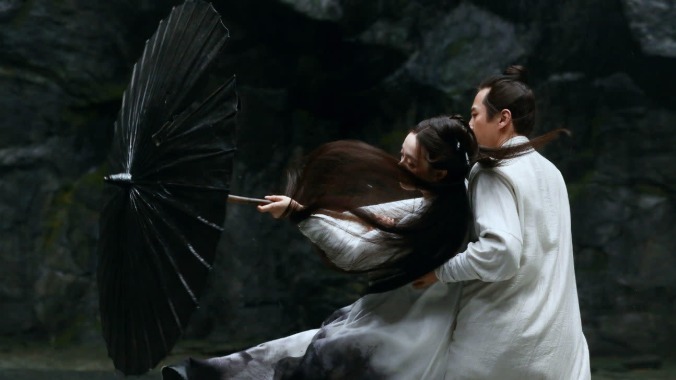Along with Yu’s confrontation with General Yang, there’s also the conflict between the king’s younger sister Qing (Guan Xiaotong) and the general’s son Ping (Leo Wu), who condescendingly offers to make Qing his concubine in response to the king’s proposal of a political marriage uniting the Pei and Yang houses. (Not his wife, mind you. His concubine.) The plucky Qing, a character whose resourcefulness and bravery resemble that of Black Panther’s Shuri, agrees to the arrangement. But, like Commander Yu, she has further plans that she’s keeping to herself. Also in play are the mysterious Captain Tian (Wang Qianyuan) and his ragtag army of transients, all of whom are trained in a balletic form of umbrella-based combat by Yu’s wife, Madam (Sun Li).
Madam comes up with this fighting style in an epiphany inspired by the philosophical concept of yin and yang, the interconnected-yet-opposing dual forces whose balance keeps the universe in harmony. General Yang is known for his brutally powerful, hyper-masculine fighting style, she reasons, so what better to counter it than feminine footwork and subtle movements? This idea eventually evolves into something a little more badass—in a blend of the eponymous weapon from the wuxia classic Master Of The Flying Guillotine and the hidden blade wielded by the heroine of the Japanese film Lady Snowblood, Captain Tian’s army marches to retake Jingzhou wielding umbrellas made of boomerang-shaped blades that turn into deadly projectiles with a simple flick of the wrist. In the film’s most memorable image, legendary action director Huen Chiu Ku, a.k.a. Dee Dee, shows the same gift for inventive chaos he brought to the House Of Blue Leaves sequence in Kill Bill: Vol. 1 by turning Tian’s foot soldiers into twirling hedgehogs of death when they come pouring down the hill that leads into the city curled up between two bladed umbrellas.
But the concept of connected opposites permeates every aspect of Shadow, from its production design to its dialogue. There’s the literal tai chi diagram that adorns the secret cave where Yu trains his double, a commoner by the name of Jing, to fight like the real thing, of course. But the personalities of the two men—one cynical and privileged, the other optimistic and impoverished—also exist in balance, with Madam caught in the middle. These parallels extend into the film’s technical features, as when Yimou punctuates fight scenes with both bone-crunchingly heavy sound effects and ephemeral slo-mo shots of bodies rotating weightlessly in midair.
Most significantly, however, this through-line informs Shadow’s breathtaking visuals, which are on par with the heightened fairytale aesthetics of Yimou’s celebrated mid-’00s wuxia epics. As mentioned above, aside from skin tones and blood, black and white are the only colors in Yimou’s palette, and he swirls them together in fluid watercolor patterns that, combined with the perpetually rain-soaked exteriors, recreate the elegant ink-brush strokes of classical Chinese painting. That constant, pouring rain also lends a certain sodden weight to the fight scenes, which mostly take place outdoors; contrast that with the light, windswept movements of silk and hair rustling in gentle breezes in the dialogue-heavy interior scenes—particularly the stunning, expertly framed palace interiors, which convey the gap between what characters are saying and what they really mean by hiding them behind layers of intricately illustrated screens.
By the time the film reaches its Shakespearean climax, it’s all been swept up into a churning cyclone of deception and violence, a technique that makes Shadow anything but a casual watch if you want to have any hope of following the plot. At the same time, however, the film’s philosophical underpinnings, and the way they’re expressed on screen, are deceptively simple—yet another pair of opposites in a film defined by them. The scales ultimately tip slightly in favor of style, but when that style is this gorgeous, remembering a movie for the way it looks rather than its plot isn’t necessarily a bad thing.



 Keep scrolling for more great stories from The A.V. Club.
Keep scrolling for more great stories from The A.V. Club.